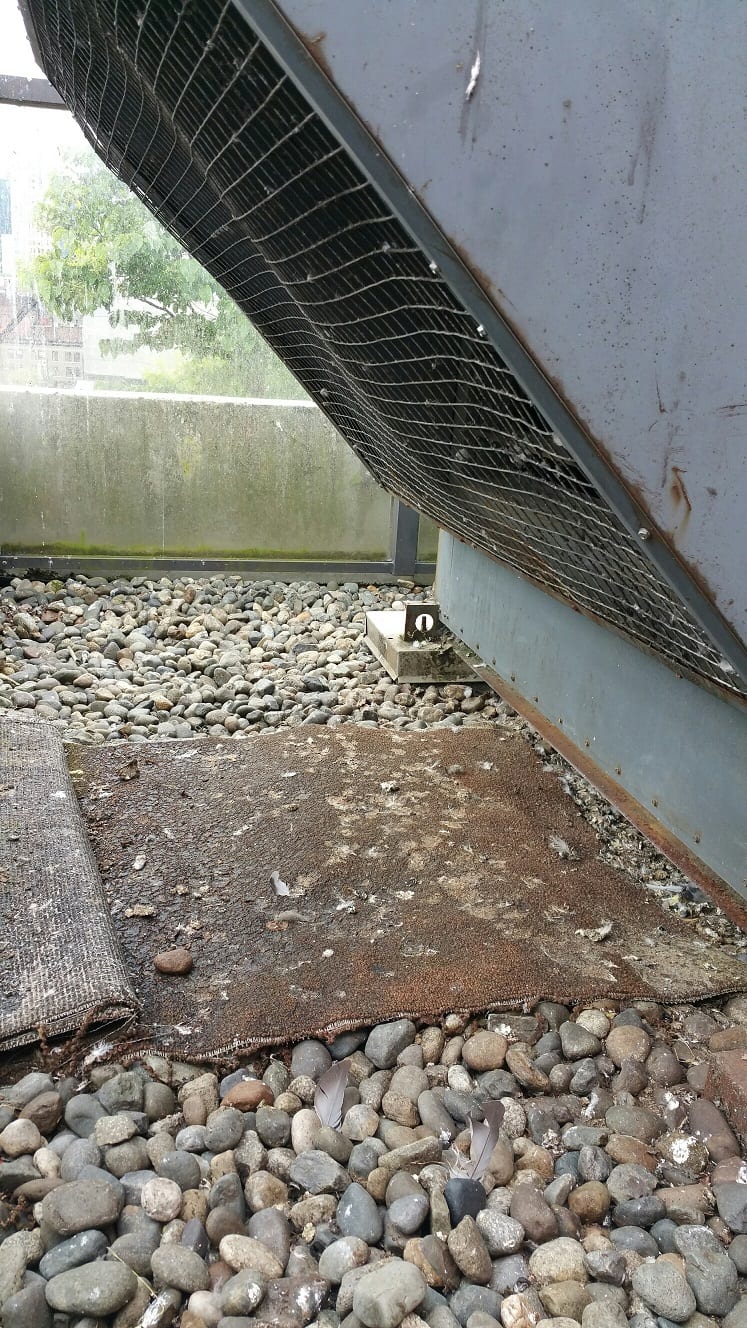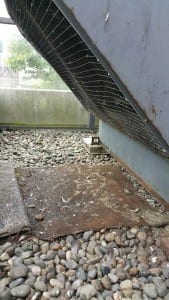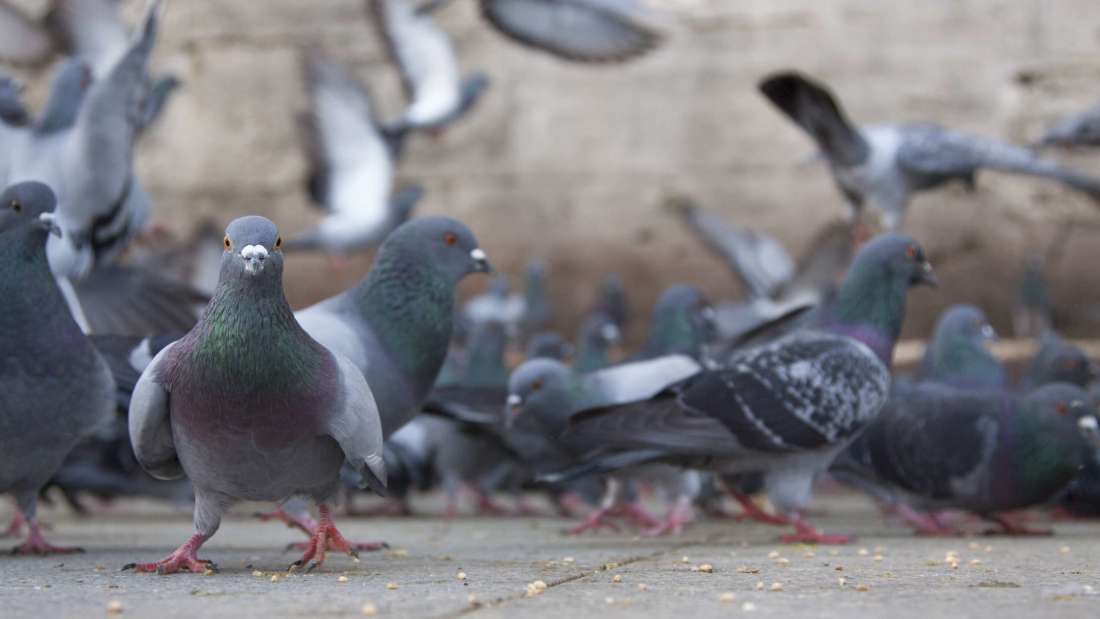
by Pigeon Patrol | Apr 18, 2023 | history of pigeons, MBCA, pet bird, Pigeon Control, Pigeon Droppings, Pigeon Patrol's Services, Pigeon Predators
When travelling in groups, animals frequently have to make decisions on the direction of travel. These decisions can be based on consensus, when all individuals take part in the decision (i.e. democratic decision; social information), or leadership, when one member or a minority of members make the decision (i.e. despotic decision; personal information). Here we investigated whether decision-making on the navigation of small flocks is based on democratic or despotic decisions. Using individual and flock releases as the experimental approach, we compared the homing performances of homing pigeons that fly singly and in groups of three. Our findings show that although small groups were either governed (i.e. when individuals in the flock had age differences) or not (i.e. when individuals in the flock had the same age) by leaders, with concern to decision-making they were all ruled by democratic decisions. Moreover, the individual homing performances were not associated with leadership. Because true leaders did not assume right away the front position in the flock, we suggest that as in human groups, starting from a central position is more effective as it allows leaders to not only transmit their own information but also to average the tendencies of the other group members. Together, the results highlight the importance of democratic decisions in group decision-making.
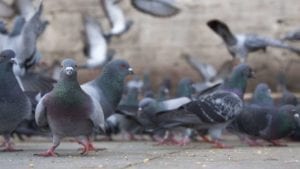
Source
Pigeon Patrol Products & Services is the leading manufacturer and distributor or bird deterrent (control) products in Canada. Pigeon Patrol products have solved pest bird problems in industrial, commercial, and residential settings since 2000, by using safe and humane bird
deterrents with only bird and animal friendly solutions. At Pigeon Patrol, we manufacture and offer a variety of bird deterrents, ranging from Ultra-flex Bird Spikes with UV protection, Bird Netting, 4-S Bird Gel and the best Ultrasonic and audible sound devices on the market today.
Voted Best Canadian wholesaler for Bird Deterrent products ten years in a row.
Contact us at 1 877-4-NO-BIRD,(604) 585-9279 or visit our website at www.pigeonpatrol.ca
Pigeon/Pigeon Patrol / Pigeons Roosing / Vancouver Pigeon Control / Bird Spikes / Bird Control / Bird Deterrent / PIgeon Deterrent / Surrey Pigeon Control / Pest / Seagull deterrent / Vancouver Pigeon Blog / Birds Inside Home / Pigeons in the cities / Ice Pigeons / What to do about pigeons / sparrows, Damage by Sparrows, How to Keep Raccoons Away, Why Are Raccoons Considered Pests / De-fence / Pigeon Nesting / Bird Droppings / Pigeon Dropping / woodpecker control / Professional Bird Control Company / Keep The Birds Away / Birds/rats/seagull/pigeon/woodpecker/dove/sparrow/pidgeon control/pidgeon problem/pidgeon control/flying rats/pigeon problems/ bird netting/bird gel/bird spray/bird nails/bird guard
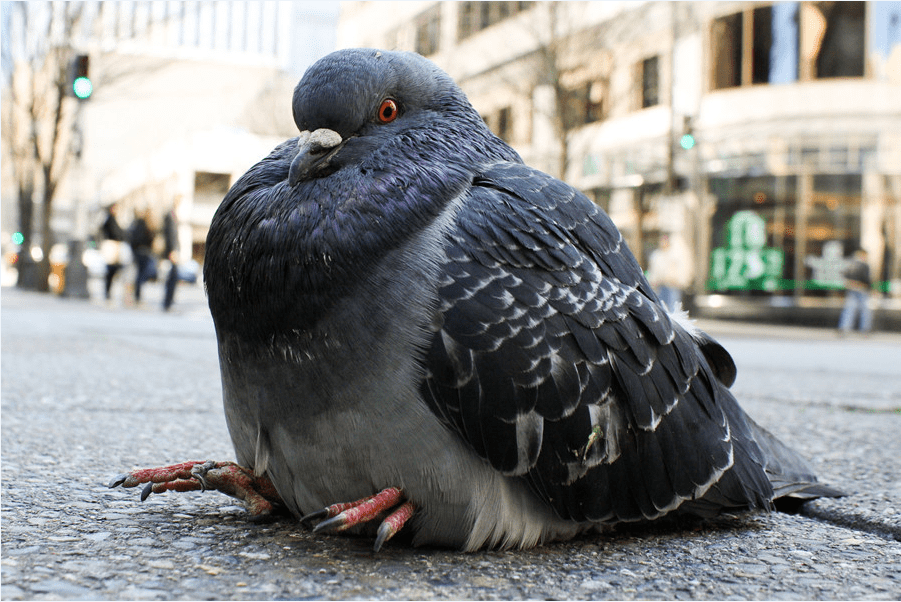
by Pigeon Patrol | Mar 23, 2023 | Columbidae, Doves, history of pigeons, MBCA, pet bird, Pigeon Control, Pigeon Droppings, Pigeon Patrol's Services
A recent first detection of pigeon aviadenovirus-1 and pigeon circovirus co-infection associated with Young Pigeon Disease Syndrome (YPDS) in a pigeon flock in Turkey, prompted a study focused on documenting the distribution of Pigeon aviadenovirus (PiAdV-1 and PiAdV-2), Pigeon circovirus (PiCV), Columbid alphaherpesvirus 1 (pigeon herpesvirus (PiHV)) and Fowl aviadenovirus (FAdV) in the country. These viruses were selected as they are associated with severe disease in pigeons across the world. A total of 192 cloacal swabs were collected from young (<1 year old) pigeons from 16 different private pigeon flocks across Turkey, between 2018 and 2021 as part of routine diagnostic sampling. PiCV genetic material was the most frequently detected 4/16 (25%), PiAdV-1 and CoHV-1 DNA were both found in one flock each, while neither PiAdV-2 and FAdV were detected in any of the studied pigeon flocks. PiCV and PiHV genetic material were both detected in the same pigeon flock’s cloacal samples as a co-infection with the identification of PiHV being a first in Turkey.
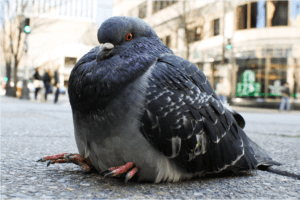
Source
Pigeon Patrol Products & Services is the leading manufacturer and distributor or bird deterrent (control) products in Canada. Pigeon Patrol products have solved pest bird problems in industrial, commercial, and residential settings since 2000, by using safe and humane bird
deterrents with only bird and animal friendly solutions. At Pigeon Patrol, we manufacture and offer a variety of bird deterrents, ranging from Ultra-flex Bird Spikes with UV protection, Bird Netting, 4-S Bird Gel and the best Ultrasonic and audible sound devices on the market today.
Voted Best Canadian wholesaler for Bird Deterrent products ten years in a row.
Contact us at 1 877-4-NO-BIRD,(604) 585-9279 or visit our website at www.pigeonpatrol.ca
Pigeon/Pigeon Patrol / Pigeons Roosing / Vancouver Pigeon Control / Bird Spikes / Bird Control / Bird Deterrent / PIgeon Deterrent / Surrey Pigeon Control / Pest / Seagull deterrent / Vancouver Pigeon Blog / Birds Inside Home / Pigeons in the cities / Ice Pigeons / What to do about pigeons / sparrows, Damage by Sparrows, How to Keep Raccoons Away, Why Are Raccoons Considered Pests / De-fence / Pigeon Nesting / Bird Droppings / Pigeon Dropping / woodpecker control / Professional Bird Control Company / Keep The Birds Away / Birds/rats/seagull/pigeon/woodpecker/dove/sparrow/pidgeon control/pidgeon problem/pidgeon control/flying rats/pigeon problems/ bird netting/bird gel/bird spray/bird nails/bird guard
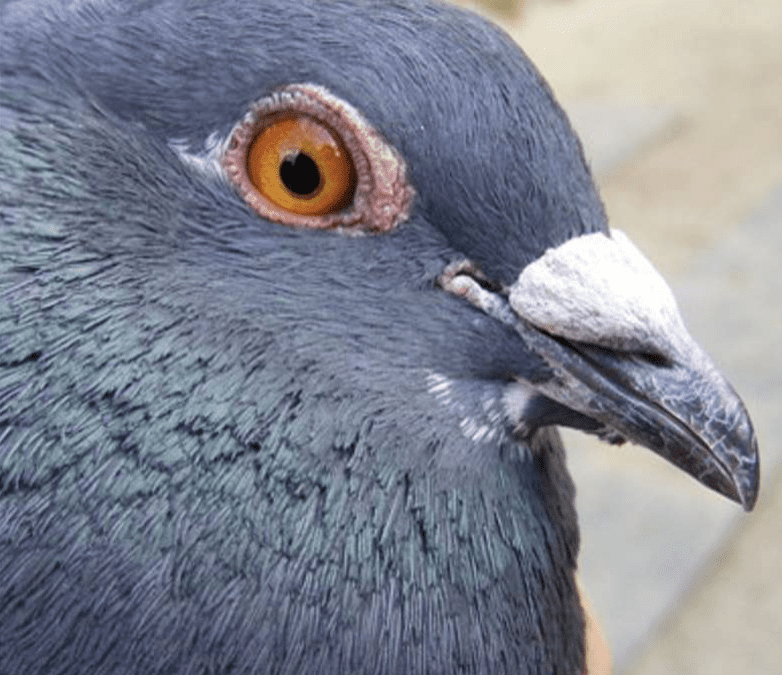
by Pigeon Patrol | Mar 16, 2023 | Bird Spike, Pigeon Droppings, Pigeon Patrol's Services, Pigeon Predators, Pigeon Spikes, Pigeons, Pigeons in the News
Pigeons in the United Kingdom have become a target of a terrible disease called the Pigeon Paramyxovirus (PPMV) or Newcastle’s Disease. It results in neurological symptoms, including trembling wings and a violently twisted neck. The affected pigeons become reluctant to move and can’t fly. They also have green feces. The disease is fatal.
A JSPCA Animal Shelter spokesperson reported that the shelter had increased the number of grounded pigeons in the last few weeks. Many affected birds had neurological symptoms, such as a twisted neck, circling, or inability to stand. The spokesperson added that these symptoms are signs of pigeon paramyxovirus that affects poultry, doves and pigeons and is invariably fatal.
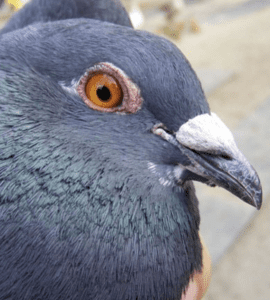
PPMV is a notifiable disease in captive birds. It does not apply to wild birds. The affected birds die within a few days, and there is no treatment for the disease. PPMV is highly infectious and can spread through feces and other excretions of the affected birds. Surviving birds will shed the virus, becoming a risk to other birds. So, at JSPCA, the infected birds are humanely euthanised. Since the PPMV virus survives better in cold and wet months, the disease’s clusters are usually found at this ..
Is PPMV highly infectious?
PPMV is highly infectious, spreading through the affected bird’s feces and other secretions.
Pigeon Patrol Products & Services is the leading manufacturer and distributor or bird deterrent (control) products in Canada. Pigeon Patrol products have solved pest bird problems in industrial, commercial, and residential settings since 2000, by using safe and humane bird
deterrents with only bird and animal friendly solutions. At Pigeon Patrol, we manufacture and offer a variety of bird deterrents, ranging from Ultra-flex Bird Spikes with UV protection, Bird Netting, 4-S Bird Gel and the best Ultrasonic and audible sound devices on the market today.
Voted Best Canadian wholesaler for Bird Deterrent products ten years in a row.
Contact us at 1 877-4-NO-BIRD,(604) 585-9279 or visit our website at www.pigeonpatrol.ca
Pigeon/Pigeon Patrol / Pigeons Roosing / Vancouver Pigeon Control / Bird Spikes / Bird Control / Bird Deterrent / PIgeon Deterrent / Surrey Pigeon Control / Pest / Seagull deterrent / Vancouver Pigeon Blog / Birds Inside Home / Pigeons in the cities / Ice Pigeons / What to do about pigeons / sparrows, Damage by Sparrows, How to Keep Raccoons Away, Why Are Raccoons Considered Pests / De-fence / Pigeon Nesting / Bird Droppings / Pigeon Dropping / woodpecker control / Professional Bird Control Company / Keep The Birds Away / Birds/rats/seagull/pigeon/woodpecker/dove/sparrow/pidgeon control/pidgeon problem/pidgeon control/flying rats/pigeon problems/ bird netting/bird gel/bird spray/bird nails/bird guard
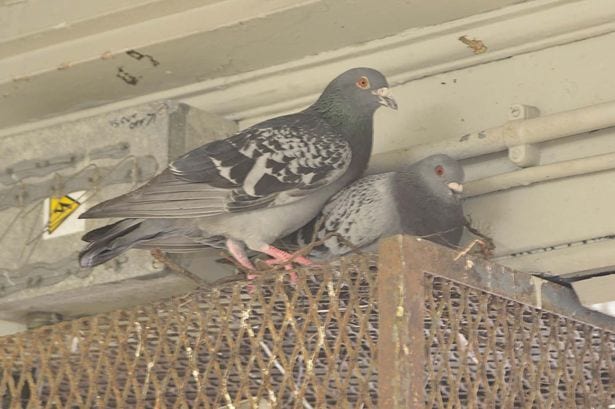
by Pigeon Patrol | Mar 6, 2023 | Bird Spike, Pigeon Patrol's Services, Pigeon Predators, Pigeon Spikes, Pigeons, Pigeons in the News, Raccoons
Pigeons in general do carry a lot of disease but most are not transferrable to humans. The one way humans can contract diseases from pigeons is by exposure to their droppings. You do not need to be in direct contact with pigeon droppings to contract the diseases it carries; these diseases can become airborne and enter your system unknowingly. With enough exposure you may begin to experience flu like symptoms or lung disease.
For those who have had minimal exposure and are in good health, it is unlikely to experience any symptoms at all from these diseases. The majority of people who have contracted diseases from pigeon droppings have recovered with no medical intervention, and if needed there are medications that can combat these diseases. If you have concerns that you have contracted one of these diseases and are experiencing severe symptoms you should go to your nearest emergency room. If your symptoms seem quite mild, you will likely recover on your own.
Can pigeon diseases kill you?
Yes pigeon diseases can kill you, while it is unlikely. Pigeon dropping related diseases can cause problems like pneumonia and even meningitis in the most extreme cases. That being said, the best way to avoid contracting pigeon-related diseases is to stay away from their droppings.
In big cities like Toronto, there are pigeons everywhere, and their droppings are also everywhere. But keep in mind that these small amounts are unlikely to make you ill if you are just walking by. On the other hand, if you see areas with large amounts of pigeon droppings in public, you should avoid these areas altogether. If you are a property owner and have large amounts of pigeon droppings on your property, you may require professional intervention including pigeon trapping and pigeon poop clean up which hawkeye can provide.
Why are pigeons harmful?
Pigeons themselves are not harmful in the sense that it is unlikely to get attacked by a pigeon, but their poop can be harmful both to your health and property. Pigeon poop contains diseases that can become airborne and infect humans unknowingly. Although the symptoms from these diseases are mostly quite mild, they can become severe and require medical intervention.
Pigeons are also harmful to your property. Pigeon droppings contain uric acid which can deteriorate roofing materials and other surfaces over time as they are highly corrosive. Many commercial and residential properties in Toronto suffer from property damage from pigeon droppings.
There are many solutions available when it comes to dealing with pigeons. Hawkeye offers cleaning, exclusion, and trapping of pigeons. Solutions are unique to each property and depend on many factors including accessibility, the number of pigeons, and their activities (perching or nesting).
Is pigeon poop harmful to humans?
Yes pigeon poop can be harmful to humans. Pigeon poop can cause diseases in humans through the inhalation of airborne particles. Many people who contract these diseases do not experience symptoms, but those that do are usually immunocompromised individuals. It is best to avoid contact with pigeon poop and if you have a large amount of pigeon poop on your property / balcony you should avoid the surrounding area until it can be properly cleaned.
Cleaning pigeon poop is not a fun activity, and many people want to leave the work to the professionals. If you are to clean up pigeon poop on your own there are certain precautions you should take to protect your health. Wearing gloves, a face mask, and safety glasses are the bare minimum in terms of protection from harmful diseases; depending on the extent of the mess you may require a ventilated mask.
Can you get sick from pigeon poop?
The short answer is yes, but here are the facts. The four main diseases to be worried about in terms of pigeons are Salmonellosis, Psittacosis, Histoplasmosis, and Cryptococcosis. All of these diseases are contracted through the inhalation of dried pigeon droppings. Although most cases are mild, it is possible to experience serious illness and it is always advised to take extreme caution and use the proper protective equipment when working with or cleaning up pigeon droppings.
Some are at a higher risk than others for contracting these diseases including individuals who have long term exposure, fail to wear protective equipment while cleaning, and those who have a compromised immune system. Although these people are at a higher risk to contract these diseases, many people who are not immunocompromised do not experience any symptoms at all.
What diseases are caused by pigeon droppings?
There are many different diseases to be worried about in terms of pigeons including Salmonellosis, Psittacosis, Histoplasmosis, and Cryptococcosis. These diseases can pose serious health risks and in rare cases can be fatal although many cases can be solved without medical intervention.
Salmonellosis is caused by Salmonella bacteria. This disease, as with all others listed above, is contracted by the inhalation of airborne particles. This bacteria is usually the cause of food poisoning and causes the same symptoms when contracted through pigeon droppings. Usually the onset of these symptoms is within 24-48 hours and surpasses entirely within 7 days with no medical intervention.
Psittacosis also known as parrot fever is caused by a bacteria, Chlamydia psittaci. Those exposed to this disease will experience symptoms (if any) within a couple weeks that resemble that of the flu. A simple blood test is able to identify the presence of this bacteria so if you are concerned, there is an easy way to see if you have contracted this disease.
Histoplasmosis is caused by a fungus named Histoplasma. This fungus lives in pigeon droppings and soil and when inhaled can pose health risks. Most cases show no signs or symptoms when infected, but those with existing conditions like emphysema can develop a chronic disease which exhibits symptoms similar to tuberculosis.
Cryptococcosis is also caused by a fungus, except this particular fungus is called Cryptococcosis neoformans. This is the most dangerous of all the diseases listed as this infection has the capacity to move from your lungs to your brain, and throughout your entire body. It is not isolated to your respiratory or digestive systems. In the majority of cases, this disease only causes infection in the lungs leaving patients with little to no symptoms, but when left untreated can lead to meningitis. The onset of this disease will happen within two weeks of exposure.
What are the signs and symptoms of Histoplasmosis?
Histoplasmosis is a fungal disease that has a wide range of symptoms ranging from no symptoms at all to chronic histoplasmosis (similar to tuberculosis) or even death in extreme cases. Signs to look out for include dry cough, chest pain, fever, chills, headache, fatigue, and joint pain.
Most cases of Histoplasmosis leave those infected experiencing little to no symptoms. Although unfortunately, those with existing lung conditions are at higher risk for developing chronic histoplasmosis. This chronic condition causes bloody cough and symptoms of tuberculosis including chest pain, weakness, chills, fever, weight loss, and fatigue.
Although unlikely, it is possible for this disease to remain dormant in your body for years producing no symptoms until far down the road from the point of exposure so always ensure you protect yourself with the proper protective equipment when dealing around pigeon droppings.
What are the signs and symptoms of Psittacosis?
Psittacosis is a bacterial disease that has a range of symptoms that are mostly mild but can become severe if prolonged symptoms are left untreated. Mild symptoms include muscle pains, cough, chills, headache, and fever. More severe symptoms include chest pain, pneumonia, and difficulty breathing.
Although this disease is very rare in humans, it can become quite serious once infected so be sure to use the proper precautions when you are cleaning or in the presence of pigeon poop. Proper protective equipment including gloves, mask, and googles should be warn whenever in contact or in the vicinity of large amounts of pigeon droppings.
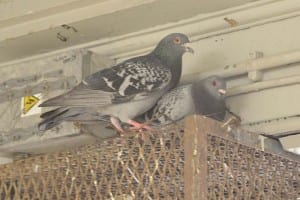
How do you clean pigeon droppings?
When cleaning pigeon droppings the most important thing is protection from potential diseases. Wearing a mask, gloves, and googles / safety glasses is recommended at all times. This personal protective equipment with protect you from breathing in airborne particles and will keep your hands clean to avoid spreading germs to other locations.
To start, the bulk of the pigeon droppings should be swept or shovelled into double bags and disposed of. If possible, steam cleaning is the most effective solution to clean and sanitize areas affected by pigeon poop. In some cases pressure washing may be used instead. If there is no access to a water attachment or you are on a balcony with no drainage, this solution is not feasible and hand tools must be used instead. Hand tools include brushes and scrapers and will require the use of a diluted bleach or disinfectant to properly clean and sanitize the area. Using hand tools on porous materials can be difficult and may require using boiling water to properly disinfect the area.
How do I get rid of pigeon poop on my balcony?
Balconies are the perfect place for pigeons to perch, nest, and poop. The mess that these birds make can render your balcony unusable. Luckily there are solutions available to solve these problems. Hawkeye offers balcony netting and clean up to keep the pigeons off your balcony for good.
Balcony netting is designed to keep pigeons from perching on your balcony and accessing your balcony all together. This netting is made of a black 2 inch heavy duty, polyethylene, 4 strand, knotted twine. This netting comes with a 10 year warranty on materials and workmanship and is the perfect way to keep pigeons off your balcony permanently.
In terms of clean up, different tools can be used depending on accessibility and practicality. Most balconies do not provide access to use a pressure washer or steam cleaner, which leaves only hand tools to perform clean up. Cleaning up the bulk of poop and nesting material is done using brooms and shovels. Deep cleaning is done using brushes and scrapers. Most surfaces will allow us to use a diluted bleach solution which will help to sanitize and clean the surfaces contaminated with droppings. When only hand tools are used, if available, we may require the customer to provide us with some boiling water to assist in stubborn clean ups.
How much does it cost to remove a pigeon?
Pigeon trapping includes the live trapping of pigeons and humane euthanizing of caught pigeons as to permanently remove the nuisance birds from your property. Depending on the amount of pigeons frequently seen on your property a decision will be made between the customer and the technician as to how many traps should be installed on site.
Pigeon poop cleaning is quoted based on two different things; types of tools used (power vs hand tools) and how long it will take for us to clean.
Balcony netting is the main form of exclusion used for residential customers in condo or apartment buildings dealing with pigeon problems.
We also offer other exclusion services including bird spikes, flex track, bird slide, bird wire, and netting for areas other than balconies. All of these exclusion methods can be used to prevent pigeons from perching or nesting in problem areas around your property. These products range greatly in price and the prices are determined based on the size of project, equipment required, man power required, and materials required.
Source
Pigeon Patrol Products & Services is the leading manufacturer and distributor or bird deterrent (control) products in Canada. Pigeon Patrol products have solved pest bird problems in industrial, commercial, and residential settings since 2000, by using safe and humane bird
deterrents with only bird and animal friendly solutions. At Pigeon Patrol, we manufacture and offer a variety of bird deterrents, ranging from Ultra-flex Bird Spikes with UV protection, Bird Netting, 4-S Bird Gel and the best Ultrasonic and audible sound devices on the market today.
Voted Best Canadian wholesaler for Bird Deterrent products ten years in a row.
Contact us at 1 877-4-NO-BIRD,(604) 585-9279 or visit our website at www.pigeonpatrol.ca
Pigeon/Pigeon Patrol / Pigeons Roosing / Vancouver Pigeon Control / Bird Spikes / Bird Control / Bird Deterrent / PIgeon Deterrent / Surrey Pigeon Control / Pest / Seagull deterrent / Vancouver Pigeon Blog / Birds Inside Home / Pigeons in the cities / Ice Pigeons / What to do about pigeons / sparrows, Damage by Sparrows, How to Keep Raccoons Away, Why Are Raccoons Considered Pests / De-fence / Pigeon Nesting / Bird Droppings / Pigeon Dropping / woodpecker control / Professional Bird Control Company / Keep The Birds Away / Birds/rats/seagull/pigeon/woodpecker/dove/sparrow/pidgeon control/pidgeon problem/pidgeon control/flying rats/pigeon problems/ bird netting/bird gel/bird spray/bird nails/bird guard
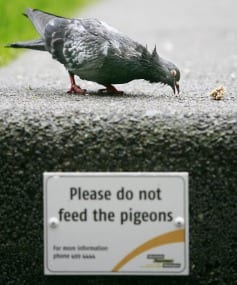
by Pigeon Patrol | Mar 6, 2023 | MBCA, pet bird, Pigeon Control, Pigeon Droppings, Pigeon Patrol's Services, Pigeon Predators
In January 2019, a child died in a Scottish hospital after developing a fungal infection caused by exposure to pigeon droppings. An elderly patient also died in the same hospital of another condition that was exacerbated by exposure to pigeon droppings. It was determined that both patients were exposed to the contaminants via the ventilation system, which was found to contain pigeon droppings. These deaths brought to the forefront a question that many people who are living with pigeon infestations have: in addition to being disruptive, are pigeons actually dangerous? Here are the facts you need to know.
Pigeon droppings contain bacteria and fungi that can cause disease.
Exposure to pigeon droppings can lead to a number of different diseases. Some of the most common infections associated with pigeons are:
· E. coli: E. coli infections are usually the result of pigeon droppings being present in water or in food that is later consumed. This infection causes nausea, abdominal cramps, fever, and vomiting.
· Histoplasmosis: This is a dangerous fungal infection that affects the lungs, or rarely, other parts of the body. It causes flu-like symptoms, including fever, shortness of breath, chest pain, fatigue, and loss of appetite. It can be fatal in severe cases.
· Cryptococcus: This is another fungal infection that affects the lungs and can spread to the brain. In its early stages, it can cause a cough, chest pain, fever, and shortness of breath. When it spreads to the lungs, it causes headaches, neck pain, changes in behavior, confusion, and sensitivity to light. It can also be fatal.
· Psittacosis: Psittacosis is a bacterial infection that causes fever, headaches, a rash, and can lead to pneumonia, if left untreated.
· Candidiasis: This fungal infection can affect multiple parts of the body, including the mouth, lungs, urogenital tract, and skin. This infection may require prolonged periods of antifungal medications to treat.
· Salmonellosis: Pigeon droppings may contain the bacteria salmonella, which can cause this infection. Typically, people are exposed to these bacteria when pigeon droppings come into contact with food or food preparation surfaces. This infection causes nausea, vomiting, and abdominal cramps.
Pigeons also carry other potential health risks.
It is not just the droppings of pigeons that are dangerous. Pigeons themselves can carry mites and fleas, which can then attach to your pets or enter your home, causing skin irritation and itchiness. They can also spread infections through bites that are dangerous to both people and pets.
Pigeons can also carry West Nile virus. Although people are unlikely to contract West Nile virus directly from pigeons, it is still important to avoid removing any dead pigeons from your property without the help of a professional for this reason.

People with weakened immune systems are most at risk.
The infections that pigeons are likely to transmit do not affect everyone at the same rate. Many healthy adults are able to fight off infections caused by exposure to bacteria and fungi from pigeon droppings. If they do become ill, then they are likely to have very mild infections.
However, although it is always possible for someone who is healthy to become very ill from these conditions, other people are more at risk. Infants and children are more likely to experience severe symptoms when they are exposed to a disease via pigeon droppings. People who are immuno-compromised, such as people with HIV or who are undergoing chemotherapy, also have a higher risk of developing severe symptoms and complications. Lastly, the elderly are prone to severe symptoms from pigeon-related diseases.
Even without exposure to a disease, some people may have allergy symptoms, including respiratory problems, rashes, and itchiness, as a result of a pigeon infestation near their home or business.
For safety reasons, only professionals should handle pigeon control.
If you have a pigeon infestation, it’s important to deal with the issue as soon as possible. However, trying to get rid of pigeons and clean up their droppings on your own is not safe. Pigeon control professionals are trained in safe management techniques and have the proper equipment required to clean up after a pigeon infestation safely.
One of the biggest risks of cleaning up pigeon droppings on your own is that you could release dust into the air that contains bacteria and fungi that cause infection. Not only would you be at risk from inhaling the bacteria and fungi yourself, but you could also inadvertently introduce the contaminants into the HVAC system in your home, allowing them to spread into your indoor air and putting your family at risk.
Source
Pigeon Patrol Products & Services is the leading manufacturer and distributor or bird deterrent (control) products in Canada. Pigeon Patrol products have solved pest bird problems in industrial, commercial, and residential settings since 2000, by using safe and humane bird
deterrents with only bird and animal friendly solutions. At Pigeon Patrol, we manufacture and offer a variety of bird deterrents, ranging from Ultra-flex Bird Spikes with UV protection, Bird Netting, 4-S Bird Gel and the best Ultrasonic and audible sound devices on the market today.
Voted Best Canadian wholesaler for Bird Deterrent products ten years in a row.
Contact us at 1 877-4-NO-BIRD,(604) 585-9279 or visit our website at www.pigeonpatrol.ca
Pigeon/Pigeon Patrol / Pigeons Roosing / Vancouver Pigeon Control / Bird Spikes / Bird Control / Bird Deterrent / PIgeon Deterrent / Surrey Pigeon Control / Pest / Seagull deterrent / Vancouver Pigeon Blog / Birds Inside Home / Pigeons in the cities / Ice Pigeons / What to do about pigeons / sparrows, Damage by Sparrows, How to Keep Raccoons Away, Why Are Raccoons Considered Pests / De-fence / Pigeon Nesting / Bird Droppings / Pigeon Dropping / woodpecker control / Professional Bird Control Company / Keep The Birds Away / Birds/rats/seagull/pigeon/woodpecker/dove/sparrow/pidgeon control/pidgeon problem/pidgeon control/flying rats/pigeon problems/ bird netting/bird gel/bird spray/bird nails/bird guard







